Sphinginae subfamily
Sphingini tribe:
 |
This species would only be enountered in Newport County as a stray
from much further south.
The moth is a very strong flier and is
frequently encountered far north of its usual range.
|
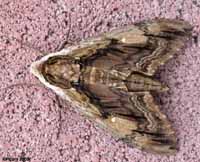 |
Ceratomia amyntor
WO,
the Elm Sphinx or Four-horned Sphinx
The upperside of the forewing is brown with dark brown and white
markings including a white costal area near the wing base, dark
streaks along the veins, and a white spot in the cell.
Larvae feed on Elm (Ulmus), birch (Betula), basswood (Tilia), and cherry (Prunus).
|
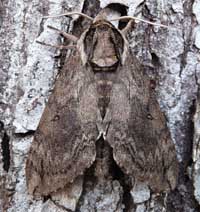 |
This is generally a more southerly species, but it may be present in
Bristol County near Catalpa Trees.
I saw them in great numbers in New Jersey. The larvae feed in large groups and are much more
spectacular than the moths.
Catalpa is the larval host.
|
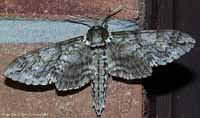 |
The upperside of the forewing is pale brownish gray with wavy black
and white lines and a black-outlined white cell spot. The upperside
of the hindwing is gray with diffuse darker bands.
|
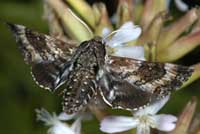 |
Dolba hyloeus
WO, the Pawpaw Sphinx
The upperside of the forewing is dark brown with a dusting of white
scales. Some moths have patches of reddish or yellowish brown on the
wings. Larve are not limited to pawpaw.
|
 |
The upperside of the forewing is gray with heavy black bands. The
upperside of the hindwing is brownish gray with no markings.
|
 |
The upperside is of the forewing is gray with two (sometimes one or
three) black dashes near the wing center; other markings are usually
diffuse. The upperside of the hindwing is a uniform brown-gray.
|
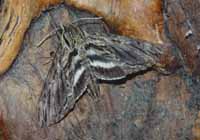 |
The upperside of the forewing is gray-brown with wavy lines, black
dashes, and one or two small white spots near the center of the
costa. |
 |
This species is not recorded in Bristol County and usually is not
found north of Connecticut. This moth is a strong flier and may
occasionally stray into Rhode Island.
|
 |
Manduca quinquemaculatus
WO the Five-spotted Hawkmoth
The moth abdomen usually has five but sometimes six pairs of yellow
bands. The upperside of the forewing is blurry brown and gray. I
suspect if you grow tomatoes you have encountered it.
|
 |
Look for three large yellow spots
on each side of the abdomen. The upperside of the forewing is
yellowish brown to deep chocolate brown with a dusting of white
scales and zigzagged black and white lines.unlikely stray
|
 |
If you grow tomatoes, you have probably encountered it.
Larvae get very large and can strip a tomato plant.
|
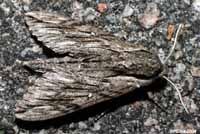 |
The upperside of the forewing is gray with indistinct black and white
markings. There is a series of black dashes from the base to the tip,
and a small white cell spot.
|
 |
Sphinx chersis
WO, the Northern Ash Sphinx or Great Ash
Sphinx
The upperside of the forewing is soft dark gray to blue-gray with
a series of black dashes, one of which reaches the wing tip.
Larval hosts are ash, lilac, privet, cherry, and quaking aspen.
|
 |
Sphinx drupiferarum
WO, the Wild Cherry
Sphinx
Sphinx drupiferarum larvae hide in the day and feed primarily on
cherry, plum, and apple at night.
Larvae have been found on Amelanchier nantuckensis in Massachusetts.
|
 |
This species is present in Newport County.
Colouration and markings are highly variable from one specimen to
another. The fringes on forewing are mostly
black with some white; those on the hindwing are mostly white with a
few black patches. |
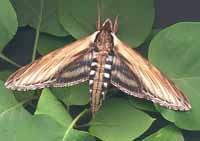 |
The lower forewings are predominantly brownish-yellow with a fairly
wide dark bar along the inner margin. At rest the wings hug the body,
giving the moth a long slender look.
|
 |
If you have blueberries in the woods, then you might have the Poecila Sphinx.
They are pretty common here on Prince Edward Island, but don't fly
too far south of Massachusetts, being replaced by Sphinx gordius
in Connecticut. |
Smerinthini Tribe:
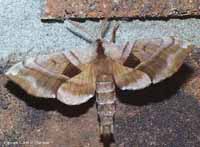 |
The adults are also highly variable; sometimes wings of an individual
may be all one color or may have several colors, ranging from pale to
dark brown, and may have a white or pink tinge.
See the file for the female; she is different.
|
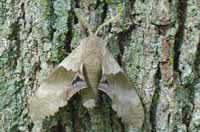 |
Pachysphinx modesta
WO, the Modest Sphinx or Poplar Sphinx
This moth is not officially reported from Bristol County, but it may be
present.
They are common on Prince Edward Island.
|
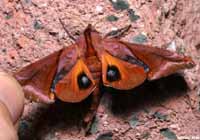 |
Paonias astylus, the Huckleberry Sphinx (wingspan 55-65 mm), ranges
from Maine south to Florida, west to Missouri and Mississippi.
|
 |
Named for the dull grey-blue spot in the hindwing, this moth has a
wide distribution and is probably common in Newport County.
I regularly see them on Prince Edward Island, and they are reported as far south as Florida.
|
 |
Named for the small eye-spot in the hindwing, this moth has a wide
distribution and is probably common in Bristol County.
I regularly see them on Prince Edward Island, and they are reported
as far south as Florida.
|
 |
Smerinthus cerisyi
WO,
the Cerisyi's Sphinx
Smerinthus cerisyi is found in the southern regions of all Canadian
provinces and in northern border states. The one-eyed sphinx is also
found along the U.S. west coast, eastward to the Rockies. At my home
in Montague, P.E.I., Canada, they are quite common.
|
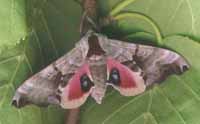 |
Smerinthus jamaicensis
WO, the Twin-spotted Sphinx
Smerinthus jamaicensis closely resembles Smerinthus cerisyi, but
jamaicensis is much smaller with larger blue patches on more vibrant
and deeper purple in the lower wings.
Along the East Coast, it flies from P.E.I. to Florida.
|
Macroglossinae subfamily
Dilophonotini tribe:
See Hemaris comparison to help distinguish
the next three species.
 |
Hemaris diffinis
WO, the Snowberry Clearwing or Bumblebee
Moth
Adults mimic bumblebees and are quite variable, both geographically
and seasonally. The wings are basically clear, with dark brown to
brownish-orange veins, bases and edges.
|
 |
Hemaris gracilis
WO, The Slender Clearwing or Graceful
Clearwing
This day flier is not commonly reported, but is probably
present in Newport.
|
 |
Hemaris thysbe
WO, the
Hummingbird Clearwing This interesting day flier is not confirmed for
Bristol.
They are widely distributed in the east from P.E.I. to Florida.
|
Philampelini tribe:
 |
This moth is not reported for Newport,
but it is fairly often reported
along the coast from southern New Jersey
to central Maine.
Note the differences between this moth and the Pandorus Sphinx. |
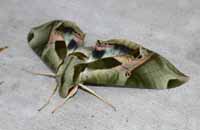 |
If you have Grape or Virginia Creeper nearby, then you probably have
this species. I often get asked to identify larvae from areas where
they have not previously been reported.
|
Macroglossini tribe:
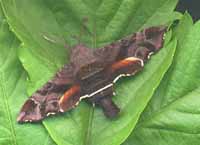 |
This day flier is widely distributed although not
officially recorded in Newport County. If you have Virginia Creeper,
you probably have the Nessus Sphinx.
Two bright, distinct, narrow
yellow bands are often visible on the abdomen.
|
 |
They are common in New Jersey and common
here on Prince Edward Island.
You will often see this species listed as Darapsa pholus,
especially in older literature.
|
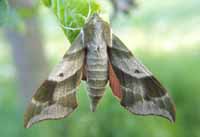 |
Darapsa myron
WO, the Virginia Creeper Sphinx or the Grapevine Sphinx
This moth is not recorded on the USGS site for Newport County.
It is widely reported as far north as southern Maine. If you have the foodplants
indicated in the common names, you probably have this species nearby. |
 |
If you have hydrangea growing near a stream, then you may have the
Hydrnagea Sphinx. It has not been widely reported, however, and
probably is uncommon.
|
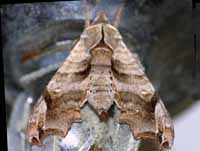 |
The moth's outer margin of the forewing is deeply scalloped.
The upperside is light brown with dark brown markings.
There is a small black and white spot near the tip.
The upperside of the hindwing is orange-brown with a dark brown outer margin and median line.
|
 |
Hyles gallii WO , the Bedstraw Hawk Moth
or Gallium Sphinx
This species is reported in nearby counties.
Some years I see them on P.E.I., some years, I do not.
|
 |
Hyles lineata
WO, the White-lined Sphinx
It is a strong migrator from the south,
and there are records from the west and to the north.
|
 |
This moth is very much under reported. It is a
rapid day flier so is probably not in too many collections.
Grape is a popular larval host.
|
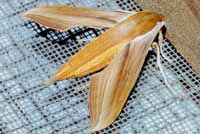 |
The upperside of the forewing is pale brown with lavender-gray at the
base and has dark brown lengthwise lines throughout. The upperside of
the hindwing is dark brown with a band of whitish, wedge-shaped
marks. only as a possible stray
|
|
|
